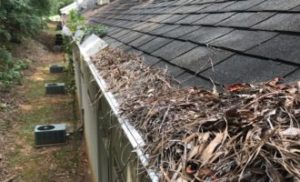 We wondered, do gutter guards really work and what are the cash savings if any from installing these guards? The principal is that water running down your roof carrying debris will be separated by the gutter guard. The water going into the eaves trough will be carried into the downspout. Debris will be washed over the edge and down onto the ground. Without a guard, annual cleaning is needed to avoid situations like the one shown in the picture. The gutters quickly fill up if you have trees nearby.
We wondered, do gutter guards really work and what are the cash savings if any from installing these guards? The principal is that water running down your roof carrying debris will be separated by the gutter guard. The water going into the eaves trough will be carried into the downspout. Debris will be washed over the edge and down onto the ground. Without a guard, annual cleaning is needed to avoid situations like the one shown in the picture. The gutters quickly fill up if you have trees nearby.
If you do not clean the gutters, dampness remains in the gutter causing mold and can cause the roof to become spongy and rotten under the shingles. Gutter cleaning could cost from $100 to $200 or even more depend on how many feet of gutter you have. With lots of trees, you may have to have them cleaned twice a year. Over 10 years, that’s $2000 assuming that you hire someone to do the work for you.
Do Gutter Guards Really Work
There are several different types of gutter guards. in situations with heavy rain, most will cause the water coming off the roof to just wash over the gutter and onto the ground. If you do not have heavy rains very often, this may not be an issue for you. Depending on the gutter guard you choose, there still may be a need to clean debris off of the guards and in one case to remove seeds that can embed themselves and sprout. Here are the different types of guards and specific issues you should consider for each in addition to those mentioned above.
More Information
-
Reverse Curve Guards – These are typically made from metal or vinyl and sit over the gutter opening. They essentially form a cover that allows water to slip around the guard but prevents large debris from coming to rest in the gutter. High volumes of water will simply overshoot the gutter and fall to the ground below.
-
Slit Gutter Covers – These are a variant of the reverse-curve and usually include one or two recessed slots that increase the amount of rainwater that can flow into the gutter. These systems also struggle to manage heavy downpours like the simple recurve system.
-
Sponge Guards – This approach places a sponge that is shaped to conform to the inside of your gutter. Water flows through and since the mass of the sponge fills the gutter space, large debris cannot accumulate. The real downside is that small debris particularly seeds can get caught in the sponge and sprout.
-
Metal Screens – These curved screens come in short sections and fasten onto the outer lip of the gutter. They are inexpensive and easy to install but are susceptible to clogging because the opening size in the mesh catches small debris.
-
Micro-Mesh Gutter Guards – Micro mesh guards consist of a support frame and a filtering mesh material which ranges from fine to micro mesh. The advantage of micro-mesh technology is that they provide the best flow-through characteristics and do not clog with small debris. While their performance is superior the only real drawback is that the systems are more complicated to install.
How Much do You Want to Spend
They all come at a price, some more expensive than others and some are easier or difficult to install. Based on the concerns expressed for each it is obvious that some level of maintenance will still be required.
Before you invest in gutter guards, compare the cost of installation including materials. Consider annual maintenance from time to time. Compare with the cost of just having your gutters cleaned out once or twice a year. If you are ok with climbing ladders, factor the do it yourself cost as part of the comparison.